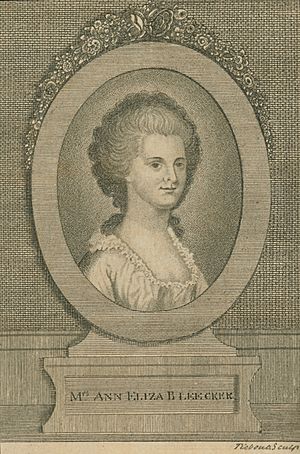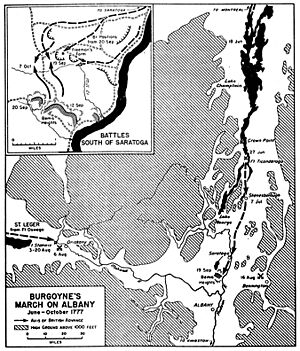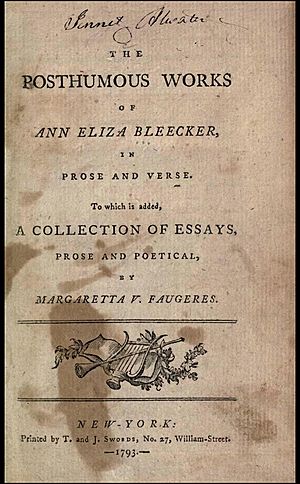Ann Eliza Bleecker facts for kids
Quick facts for kids
Ann Eliza Bleecker
|
|
|---|---|

Engraving from frontispiece of Posthumous Works, published 1793 by her daughter Margaretta V. Fuageres
|
|
| Born | Ann Eliza Schuyler October 1752 Albany, New York |
| Died | November 23, 1783 Albany, New York |
| Nationality | American |
| Genre | Pastoral poetry, captivity narrative |
| Notable works | The History of Maria Kittle |
| Spouse | John James Bleecker |
Ann Eliza Bleecker (born October 1752 – died November 23, 1783) was an American poet and writer. She grew up in New York and married John James Bleecker, a lawyer, in 1769. He really encouraged her writing. He even helped her publish a small magazine that featured her poems and stories.
During the American Revolution, John joined the New York Militia. Ann had to escape with their two young daughters. She kept writing even during these tough times. After the war, she returned home, but she was deeply affected by the deaths of many family members. Ann Eliza Bleecker passed away in 1783.
Today, historians study Bleecker's pastoral poetry to understand what life was like during the American Revolution. Her novel, Maria Kittle, was one of the first known captivity novels. It helped shape how future "Indian Capture" stories were written, which became very popular after her death.
Contents
Ann Eliza's Early Life
Ann Eliza Schuyler was born in October 1752 in Albany, which was then part of the Province of New York. She was the sixth child of Margareta Van Wyck and Brandt Schuyler. Her parents were successful merchants and came from a wealthy Dutch family in America. Sadly, Ann's father died in 1752, just before she was born.
Even as a child, Ann was known for her amazing writing skills. People often asked her to read her poems aloud. Her poems could be sweet, funny, or even a bit sarcastic. She could often make up poems on the spot for her friends.
In 1760, Ann's mother remarried Anthony TenEyck. They had another daughter, Susanna. The TenEycks were also a well-known Dutch family. So, Ann Schuyler's childhood was generally happy and comfortable.
Marriage and Life in Tomhannock
On March 29, 1769, Ann Schuyler married John James Bleecker (1745–95). He was a lawyer from New Rochelle. Soon after their wedding, they moved to Poughkeepsie.
In 1771, John decided to stop practicing law and become a farmer. They moved to his country home in Tomhannock. This area was about 18 miles (29 km) north of Albany. Their home showed how wealthy they were, with beautiful gardens and fields. Ann Bleecker thought of her home as a peaceful "retreat." Most of her nature poems were written during her first five years there. She wrote letters to friends and family, describing her quiet life and the beauty around her.
Here's a small part from her poem An Evening Prospect:
-
- "Cast your eyes beyond this meadow,
- Painted by a hand divine,
- And observe the ample shadow
- of that solemn ridge of pine."
- "Cast your eyes beyond this meadow,
During this time, Ann and John had two daughters. Margaretta was born on October 11, 1771. Abeltje (Abella) was born on June 5, 1776.
John James Bleecker strongly supported Ann's writing. He called it "her genius." In the winter of 1779, Ann Bleecker even published a small periodical called the "Albany Gazette." It was filled with her essays, poems, and short stories. She created it just to share news and entertainment with her friends and family.
The American Revolution's Impact

In 1777, the American Revolutionary War changed the Bleeckers' peaceful life. British troops, led by General John Burgoyne, invaded Tomhannock from Canada. This was part of Burgoyne's plan to take control of the Hudson River. Because of this, John Bleecker joined the New York Militia. Ann Bleecker had to flee south.
Ann Bleecker was forced to walk to Albany with her two daughters. Her infant daughter, Abella, sadly died of dysentery along the way. Ann, her mother, and her sister Caty Swits continued their journey to Red Hook. But Ann's mother also died during this trip.
Ann wrote a poem, Written in the retreat from Burgoyne, about her daughter's death:
-
- At length her languid eyes clos'd from the day,
- The idol of my soul was torn away;
- Her spirit fled and left me ghastly clay!
- Then — then my soul rejected all relief,
- Comfort I wish'd not for, I lov'd my grief:
- 'Hear, my Abella!' cried I, 'hear me mourn,'
After Burgoyne surrendered on October 17, 1777, Ann Bleecker, her surviving daughter Margaretta, and her sister returned to Tomhannock. Sadly, Caty Swits (1743–77) also died during the journey back. These losses were very hard on Ann Bleecker.
Her husband continued to serve in the militia. In 1779, Ann Bleecker had to flee to Albany again with her daughter. This was possibly due to British or Native American activity. More sadness followed. In 1781, when she heard her husband had been captured, she became very unwell. Ann Bleecker never fully recovered from all these difficult events. Her daughter, Margaretta Faugeres, later said that her mother often felt very sad. This sadness showed in her writings.
Margaretta described how her mother would sometimes be very lively and write fun songs and stories. But then, deep sadness would follow. During these sad times, she would destroy any writings that weren't as gloomy as she felt.
Ann Eliza Bleecker died on November 23, 1783. She was buried in Albany.
Ann Eliza Bleecker's Writings
Ann Eliza Bleecker didn't write her works to be famous later. She mostly wrote letters to her friends and family. These letters often included her poems and short stories. Later, her daughter collected and published them.
Published After Her Death
In 1793, much of Bleecker's work was published by her daughter, Margaretta V. Bleecker Faugères. Margaretta was also a poet. She put together her mother's writings and added some of her own poems and essays. This collection was called The Posthumous Works of Ann Eliza Bleecker. It included 36 poems, 23 letters, an unfinished short novel, and The History of Maria Kittle. The History of Maria Kittle was a story about being captured during the French and Indian War. It became very popular and was published again by itself in 1797.
The Story of Maria Kittle
Bleecker's novel, The History of Maria Kittle, was a new kind of "Indian Captivity" story. It might have been the first American story that focused on Native Americans in this way. These types of stories became very popular in the late 1700s.
Maria Kittle has many parts typical of captivity stories. It describes Native Americans as cruel and shows violent scenes. It tells Maria's journey as a captive. But by the end, Maria is rescued. The story also shows strong emotions, as three women share their sad stories of losing children. This part of the story was very similar to Bleecker's own experience of losing her daughter while fleeing from the British Army. By telling her tale of loss, Bleecker hoped to help other women deal with their own sad experiences. However, these stories also sometimes made people feel prejudiced against Native Americans.
Bleecker's writing was exciting for her time. Her style added depth to a new kind of novel, called the didactic novel (a story meant to teach a lesson). She wrote in a very expressive way to share her moral lessons. She also used a special writing style called epistolary. This means the story was told through a series of letters to her half-sister, Susan Ten Eyck. In these letters, she would pause the story to talk directly to Susan.
Her Poems
Ann Eliza Bleecker's pastoral poems showed a new style of American poetry. Because she lived through the American Revolution, her poems also showed a new sense of national identity. These poems described both the beauty of the New York countryside and the terrible effects of war, suffering, and death. Bleecker wrote from the unique viewpoint of a scared young mother. Her clear descriptions of the Revolutionary War are still read by historians today.
See also
 In Spanish: Ann Eliza Bleecker para niños
In Spanish: Ann Eliza Bleecker para niños


